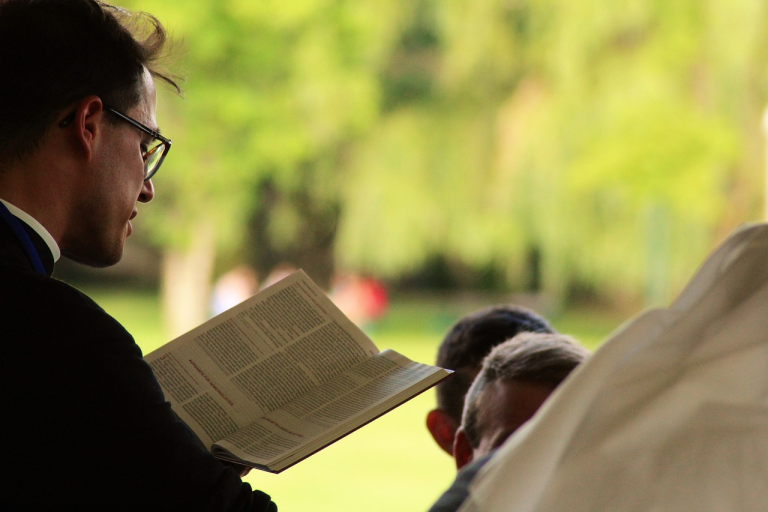The Curtain Torn in Two: What Was the Significance of the Tearing of the Veil?

In The Lord of the Rings, the Doors of Durin prevent entry into Moria beneath the Misty Mountains. In The Lion, the Witch, and the Wardrobe, a mysterious wardrobe either allows or denies access to Narnia. And in Harry Potter and the Sorcerer’s Stone, a three – headed dog named Fluffy guards the way to the underground chambers. A common element in these stories is a barrier between the characters and the place they need to reach.
In the history of Israel, the most striking example of this theme was the intricately woven curtain in the center of the place of worship. This curtain separated the Holy Place from the Most Holy Place (also known as the Holy of Holies). Priests could carry out their duties in the Holy Place regularly, but only once a year could the high priest pass through the inner curtain to enter the immediate presence of God (for example, Ex. 26:33–35; Lev. 16:2). Effectively, the curtain constantly protected the entrance to the holiest area.
There were two notable exceptions to this strict rule.
First, in a remarkable vision of the future, the book of Revelation describes how, when Christ’s eternal kingdom arrives, the heavenly temple will stand open (Rev. 11:15). The ark of the covenant, which was God’s throne in the Most Holy Place until it was lost after the Babylonians conquered Jerusalem in 586 BC, will be visible to everyone (Rev. 11:19). There will be no curtain to block the way.
But there was also a foreshadowing of this final scene on the day Jesus was crucified.
What Took Place in the Temple?
As Jesus drew his last breath, a series of extraordinary events occurred. Darkness covered the earth, an earthquake struck, the tombs of dead saints were opened, and Jesus cried out. And “the curtain of the temple was torn in two, from top to bottom” (Matt. 27:51; cf. Mark 15:38; Luke 23:45).
Although there were other curtains (in Greek, “katapetasma”) in the temple, the gospel writers were probably referring to the curtain at the entrance of the Most Holy Place. They used the definite article to specify it, and this curtain was the most important one, carrying great symbolic meaning in early Judaism (as seen in the works of Josephus in War 5.212 and Philo in Life of Moses 1.88). Any Jewish or Christian reader would immediately think of it as “the curtain” (see Heb. 9:2–3).
Amid all these apocalyptic events, this curtain “was torn” (in the passive voice) from “top to bottom.” These details suggest that God directly intervened from heaven to tear the curtain that protected his presence.
But why did this happen? At first glance, it’s a confusing detail.
What Were the Consequences of the Tearing?
1. Judgment on the Temple System
Firstly, the tearing of this crucial curtain was part of a series of signs indicating that the Jerusalem temple was losing its central role in worship. Jesus had declared that the house of God was being abandoned (Luke 13:33). He had disrupted the temple because its busy, commercial, and corrupt religious practices had turned what was supposed to be a “house of prayer” into a “den of robbers” (Mark 11:15–17). He also clearly predicted its upcoming destruction (Luke 19:41–44; Matt. 24:15–28), which came true in AD 70.
History seemed to be repeating itself.
Previously, when Israel’s religion became corrupt, God’s glory left the temple, escorted out by the cherubim when the Babylonians destroyed the temple (Ezek. 11:22–23). Similarly, the tearing of the curtain, which was likely embroidered with cherubim, indicated that Israel’s temple had become stagnant and was about to be destroyed (as noted by Tertullian in Against Marcion, 4.42).
The torn curtain was a prophetic symbol showing that the earthly temple was nearing the end of its purpose.
The curtain was, in a way, a symbol of what truly kept people from God’s presence in Jesus’s time and even today: empty religious rituals without true faith. So, the tearing of the curtain was a prophetic sign that the earthly temple was approaching its end.
Ironically, the only people likely to witness the curtain being torn were the priests who were preparing the evening sacrifices in the Holy Place. They saw the end of their religious role as the man they had rejected was being sacrificed outside the city.
2. New Access to the Father through Christ
The end of the old – covenant system made way for a new era. The torn curtain revealed that all believers now have new and unrivaled access to God.
We can see this wonderful truth in the apostle’s explanation of Jesus’s seemingly strange words about the Jerusalem temple: “Destroy this temple, and in three days I will raise it up” (John 2:19). The religious leaders were confused because it had taken 46 years to build Herod’s temple (John 2:20). But John explains, “He was speaking about the temple of his body” (John 2:21). Jesus himself is the new temple, the new Most Holy Place, and there is no curtain to stop us from having an intimate relationship with him.
Another aspect is shown in Paul’s description of the church as the new temple (1 Cor. 3:16; Eph. 2:21). The curtain in the Jerusalem temple was part of a series of barriers to entry, but Jesus removed them all.
Jesus’s act of drawing people from all nations by faith nullified the outer court of Gentiles. By making all people equal heirs of God, regardless of gender, ethnicity (Gal. 3:28), he nullified the court of women. And by making all Christians a holy priesthood (1 Pet. 2:9), he nullified the priestly courts. Throughout his ministry, Jesus broke down the barriers represented by the temple’s structure, and the inner curtain was the last one.
Now, the living God dwells not in a physical building but in the church, made up of people from all walks of life who are united to Christ. Through him, we have unobstructed access to God’s blessings.
3. Christ’s Entry into the Heavenly Realm
While most scholars stop at the above two points, I would like to suggest another possible meaning of the torn curtain, inspired by the “curtain” mentioned in the book of Hebrews (the only other New Testament references).
Hebrews describes how the true Most Holy Place is in heaven, and the earthly one is just a copy (Heb. 9:24). Against this background, Hebrews outlines Christ’s work:
- He shed his blood on earth (Heb. 13:12).
- He rose again and ascended to heaven (Heb. 4:14).
- He entered the heavenly sanctuary to offer himself before God (Heb. 9:23; 10:12–14).
- In doing so, he passed through the heavenly “inner place behind the curtain” (Heb. 6:19–20).
In fact, Hebrews states that his torn flesh on earth opened a “new and living way” through the curtain into the heavenly holy places (Heb. 10:19–20).
On Good Friday, when Jesus died, the tearing of the earthly temple’s curtain was a reflection of a heavenly event. At that moment, Jesus passed through the heavenly curtain to present his blood in the heavenly sanctuary.
Looking at the big picture, the parallel between the earthly and heavenly temples may also apply to the curtain. On Good Friday, the tearing of the earthly curtain was a sign of what was happening in heaven: Jesus was passing through the heavenly curtain to offer his blood in the heavenly sanctuary.
The earthly veil was torn, and the heavenly veil was opened. Our hope is firmly anchored within that veil (Heb. 6:19).
Unlimited Access
Finally, let’s return to the book of Revelation. The heavenly temple, the Jerusalem above, is the destiny of God’s people and includes all of creation (Rev. 21:2–3). Our king and priest, Jesus, has already entered as our forerunner. The temple of the Triune God is God himself (Rev. 21:22). The temple is open to all because it encompasses everything.
By faith, there are no longer any barriers to entry.





